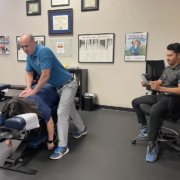Why Use a Chiropractor
Chiropractors are healthcare professionals who specialize in diagnosing and treating neuromuscular disorders, with a focus on the spine and nervous system. They use non-invasive techniques such as spinal manipulation, massage, and stretching to relieve chronic pain and improve function.
There are several reasons why someone might choose to see a chiropractor:
-
Back pain: Chiropractic care is commonly sought out for the treatment of chronic pain back pain. Chiropractors can help relieve pain by using manual techniques to realign the spine and reduce pressure on the nerves. You don’t want to rely on using pain medicine.
-
Neck pain: Chiropractors can also help with neck pain, which is often caused by poor posture or repetitive stress. By realigning the spine and improving mobility in the neck, chiropractors can reduce pain and improve function.
-
Headaches: Many headaches are caused by tension in the neck and shoulders. Chiropractic care can help reduce this tension and relieve headaches.
-
Sports injuries: Chiropractors can help athletes recover from injuries and improve their performance by addressing imbalances in the body and improving joint mobility.
-
Overall wellness: Regular chiropractic care can also help maintain overall wellness by improving spinal alignment, reducing stress, and promoting better sleep.
It’s important to note that chiropractic care should not be used as a substitute for medical care. Chiropractors work in conjunction with other healthcare professionals to provide comprehensive care.
How to choose chiropractor
Choosing a chiropractor is an important decision, as you want to ensure that you are receiving safe and effective care. Here are some tips to help you choose a chiropractor:
-
Do your research: Look for chiropractors in your area and read reviews from past patients. Check their website and social media pages for information on their qualifications and experience.
-
Check their credentials: Make sure the chiropractor is licensed to practice in your state and has the appropriate certifications and training. You can usually find this information on their website or by contacting your state’s chiropractic board.
-
Ask for referrals: Ask friends, family members, or your primary care doctor for recommendations. They may be able to refer you to a chiropractor who they trust and have had a positive experience with.
-
Schedule a consultation: Before scheduling any Pain management treatment, schedule a consultation with the chiropractor. This will give you a chance to ask questions and get a sense of their approach to care.
-
Discuss treatment options: During the consultation, the chiropractor should explain the treatment options and discuss which one would be best for your specific needs. They should also provide information on the risks and benefits of each treatment.
-
Trust your instincts: Ultimately, it’s important to choose a chiropractor who you feel comfortable with and trust. If you don’t feel comfortable with the chiropractor or their approach to care, it’s okay to look elsewhere.
Remember, chiropractic care is a form of complementary health and alternative medicine, and it’s important to always seek out medical care when necessary.
What Type Of Chiropractor Is Right For Me
Choosing whether to visit or not to see a chiropractor can depend on a variety of factors, including your specific condition, medical history, and personal preferences. Here are some things to consider when deciding if a chiropractor is right for you:
-
Your condition: Chiropractic care is generally most effective for musculoskeletal conditions such as back pain, neck pain, and headaches. If you have a condition that requires medical or surgical intervention, a chiropractor may not be the best option.
-
Your medical history: If you have a history of osteoporosis, arthritis, or certain spinal conditions, such as spinal stenosis or a herniated disc, you should consult with your primary care physician before seeing a chiropractor.
-
Your personal preferences: Chiropractic care is a non-invasive form of treatment that does not involve medications or surgery. If you prefer a more natural approach to healthcare, chiropractic care may be a good option for you.
-
Your budget: Chiropractic care can be expensive, especially if you require multiple visits. If cost is a concern, you may want to consider whether or not you can afford the out-of-pocket expenses associated with chiropractic care.
-
Your comfort level: If you are uncomfortable with manual manipulation of the spine or have a fear of chiropractic treatment, you may want to explore other treatment options.
Ultimately, the decision to see a chiropractor should be made in consultation with your primary care physician and based on your individual needs and preferences. It’s important to remember that chiropractic care should not be used as a substitute for medical care and that it’s always best to seek out medical advice and attention when necessary.
Chiropractic Techniques
Chiropractors have different techniques for treating patients. Here are some of the most common techniques:
-
Diversified Technique: This is the most common technique used by chiropractors. It involves manual adjustment of the spine to correct misalignments.
-
Activator Technique: This technique involves the use of a handheld instrument that delivers a controlled force to specific areas of the spine.
-
Gonstead Technique: This technique involves a thorough analysis of the spine to identify misalignments and then manual adjustment to correct them.
-
Thompson Technique: This technique involves the use of a drop table to assist in the adjustment of the spine.
-
Cox Flexion-Distraction: This technique involves gentle stretching and traction of the spine to treat herniated discs and other spinal conditions.
-
Applied Kinesiology: This technique uses muscle testing to diagnose and treat imbalances in the body.
-
Upper Cervical Specific: This technique involves the adjustment of the upper cervical spine to improve overall spinal alignment.
Chiropractors may also use additional therapies such as massage, heat/cold therapy, and electrical stimulation to complement their adjustments. The specific technique used by a chiropractor will depend on their training and experience, as well as the patient’s individual needs and condition.
Gender, Age and Chiropractic techniques
Gender or age do not necessarily factor into the techniques that many chiropractors use to treat patients. Instead, the technique used will depend on the individual patient’s needs, condition, and preferences, as well as the chiropractor’s training and experience. However, some patients may feel more comfortable with a chiropractor of a certain gender or age, and it’s important to choose a chiropractor who you feel comfortable with and can trust. Additionally, some chiropractors may specialize in treating certain age groups or populations, such as children or seniors, and may use techniques that are specifically tailored to those groups. Ultimately, the choice of technique should be made in consultation between the chiropractor and patient, based on the patient’s individual needs and preferences.
Chiropractors versus physical therapy
Chiropractors and physical therapists both work to improve a patient’s physical function and reduce pain, but they have different approaches to treatment of common conditions.
Chiropractors focus primarily on the spine and nervous system, using manual manipulation and adjustments to correct misalignments and improve overall spinal alignment. They also may use additional therapies such as massage, electrical stimulation, and stretching exercises to complement their adjustments.
Physical therapists, on the other hand, work with a wider range of conditions and injuries, focusing on restoring physical function through exercises, stretches, and other techniques. They may also use modalities such as ultrasound or heat/cold therapy to manage pain and promote healing.
While chiropractic care may provide more immediate relief of certain symptoms such as back pain, physical therapy focuses more on long-term management and prevention of future injuries or problems. Physical therapy also may be more appropriate for certain conditions, such as injury as post-surgical rehabilitation or neurological conditions.
Ultimately, the choice between chiropractic care and physical therapy will depend on the individual patient’s needs and condition. In some cases, a patient may benefit from both types of treatment in conjunction with each other. It’s important to consult with a medical professional to determine the most appropriate treatment plan for your individual needs.
Chiropractors versus medical doctors
Chiropractors and medical doctors are both healthcare providers, practitioners but they have different approaches to treatment and different areas of expertise.
Medical doctors typically focus on the diagnosis and treatment of diseases or conditions using medications, surgeries, and other medical interventions. They also provide preventative care, such services as annual check-ups and immunizations, and manage chronic conditions.
Chiropractors, on the other hand, focus on the musculoskeletal system and the nervous system, using non-invasive techniques such as manual adjustments, massage, and stretching exercises to improve physical function and alleviate pain. They may also provide nutritional and lifestyle counseling to promote overall health and wellness.
While medical doctors are often the first line of care for serious medical conditions or emergencies, chiropractors may be more appropriate for certain musculoskeletal conditions such as back pain, neck pain, and headaches.
It’s important to note that chiropractors are not medical doctors and do not have the same level of training, education or expertise in areas such as pharmacology or surgery. It’s always best to consult with a medical professional to determine the most appropriate course of treatment for your individual needs.
Ultimately, the choice between seeing a chiropractor or a medical doctor will depend on the individual’s condition and treatment goals. In some cases, both types of care may be necessary in conjunction with each other.
Chiropractors versus Accupuncture
Chiropractors and acupuncturists both use non-invasive techniques to promote healing and alleviate pain, but they have different approaches to treatment.
Chiropractors primarily focus on the musculoskeletal system and nervous system, using manual manipulation and adjustments to correct misalignments and improve overall spinal alignment. They may also use additional therapies such as massage, electrical stimulation, and stretching exercises to complement their adjustments.
Acupuncturists, on the other hand, use thin needles to stimulate specific points on the body to promote healing and balance in the body’s energy flow. Acupuncture is often used to treat a wide range of conditions, including chronic pain, headaches, and anxiety.
While chiropractic care may be more appropriate for musculoskeletal conditions such as pain relief as back pain, neck pain, and joint pain, acupuncture may be more appropriate for conditions such as anxiety, depression, and digestive issues.
It’s important to note that both chiropractors and acupuncturists are non-invasive, complementary therapies, and may be used in conjunction with traditional medical treatments. It’s always best to consult with a medical professional to determine the most appropriate course of treatment for your individual needs.
Ultimately, the choice between seeing a chiropractor or an acupuncturist will depend on the individual’s condition and treatment goals. In some cases, both types of care may be necessary in conjunction with each other.
Chiropractors versus massage therapists
Chiropractors and massage therapists both use manual techniques to promote healing and alleviate pain, but they have different approaches to treatment.
Chiropractors primarily focus on the musculoskeletal system and nervous system, using manual manipulation and adjustments to correct misalignments and improve overall spinal alignment. They may also use additional therapies such as massage, electrical stimulation, and stretching exercises to complement their adjustments.
Massage therapists, on the other hand, use manual techniques such as Swedish massage, deep tissue massage, and trigger point therapy to promote relaxation, alleviate muscle tension, and improve circulation.
While chiropractic care may be more appropriate for musculoskeletal conditions such as back pain, neck pain, and joint pain, massage therapy may be more appropriate for conditions such as stress, tension headaches, and soft tissue injuries.
It’s important to note that both chiropractors and massage therapists are non-invasive, complementary therapies, and may be used in conjunction with traditional medical treatments. It’s always best to consult with a medical professional to determine the most appropriate course of treatment for your individual needs.
Ultimately, the choice between seeing a chiropractor or a massage therapist will depend on the individual’s condition and treatment goals. In some cases, both types of care may be necessary in conjunction with each others other therapies.
Chiropractors versus pain management
Chiropractors and pain management specialists both work to alleviate pain, but they have different approaches to treatment.
Chiropractors primarily focus on the musculoskeletal system and nervous system, using manual manipulation and adjustments to correct misalignments and improve overall spinal alignment. They may also use additional therapies such as massage, electrical stimulation, and stretching exercises to complement their adjustments.
Pain management specialists, on the other hand, use a variety of techniques to manage pain, including medications, nerve blocks, and other interventions. They may also use complementary therapies such as physical therapy or cognitive-behavioral therapy to help patients manage their pain.
While chiropractic care may be more appropriate for musculoskeletal conditions such as back pain, neck pain, and joint pain, pain management may be more appropriate for chronic pain conditions or more complex cases where a multi-disciplinary approach to pain medicine is necessary.
It’s important to note that both chiropractors and pain management specialists are non-invasive, complementary therapies, and may be used in conjunction with traditional medical treatments. It’s always best to consult with a medical professional to determine the most appropriate course of treatment for your individual needs.
Ultimately, the choice between seeing a chiropractor or a pain management specialist will depend on the individual’s condition and treatment goals. In some cases, both types of care may be necessary in conjunction with each other.
How To Find A Good Chiropractor Near Me – Pain Doctor
Chiropractic is important in managing pain. A chiropractor helps you align your spinal alignment to support a strong body. One thing that is very difficult when it comes to chiropractic treatment is finding a very good chiropractor nearby. The prospect is frightening. Going online can’t give me any information about chiropractors. What is advisable when searching for the best chiropractic office in the area?
Free Initial Consultation at Camelback Medical Centers
Chiropractor in Scottsdale, Phoenix, Naperville
Camelback Medical Centers provides the best in chiropractic at an affordable price, with locations in Scottsdale, Phoenix and Naperville. Visit Camelback chiropractor and pain clinic for chiropractic, medical & physical therapy.
Our well trained and experienced chiropractors, therapists and medical providers use an integrated approach to help you feel better now and keep you feeling better in the future.
Come see us at Camelback Medical Centers, for your Free Initial Consultation today! We are happy to take same day appointments and walks-ins at any of our convenient locations in Scottsdale, Phoenix or Naperville.
For more informations on our Chiropractor Centers and Pain Clinics, please visit our website or make an appointment.

















